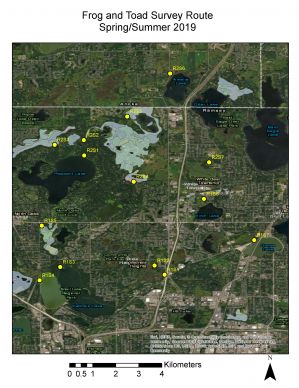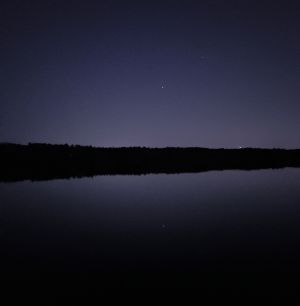Frog and toad call survey underway
We are making it a priority to better understand our wetlands. One way we are doing that is by conducting a frog and toad call survey. Frogs and toads are easy to identify by their calls. It just takes a little practice. Based on range maps, we may have up to 10 of the 14 species found in Minnesota in our watershed.
Here is a link to common species from the Minnesota Pollution Control Agency (MPCA):
We want to know which species are in our watershed and how abundant they are. Frogs and toads call at different times of the season. Boreal chorus and Wood frogs start calling early, while Mink and Green frogs call late. Of course, species overlap when they call, and timing is variable depending upon weather conditions. To capture all of the species in an area, we do 3 runs on a survey route. The first run takes place between April 15-30, the second is May 20-June 5, and the third is June 25-July 10.

We selected sampling points to represent the variety of wetlands and subwatersheds in our watershed. We did our first run on April 23 and heard 4 species: Spring peepers, Boreal chorus frogs, Wood frogs, and Northern leopard frogs. Already, we are hearing things that pique our interest. Spring peepers are thought to be declining in the metro area because of a loss of wooded wetlands. We heard Spring peepers at 64% of our stops, but the chorus wasn’t complete and often was composed of only a few individuals. If you’ve heard a strong chorus of peepers, you know what I mean. They can be incredibly loud. We want to know if we didn’t hear as much because peepers are just beginning to call for their breeding season, or if the population is small. Trends through time will tell us that.
We noticed, anecdotally at this point, that often the large wetlands with dense reeds and cattails did not have many frogs calling. Smaller, ephemeral, and some mitigation wetlands were a cacophony of sound, which may be telling us important information about specific wetlands in our watershed and their importance to amphibians.
Vadnais-Sucker Lakes Regional Park is an excellent place to hear frogs and toads. All 4 species were present at the parking lot at the north shore of East Vadnais Lake. Stop by to practice your call ID skills.
We’ll keep you posted as we learn more. For now, check out a recording from our first run of the survey and see if you can pick out the 3 species that are calling based on my description:
Sounds of a spring evening at Vadnais-Sucker Lakes Regional Park:
When I listen to the recording, the first sound that I focus on is the loud, high-pitched call of the Spring peeper. These frogs are surprisingly loud for their tiny size. Next, I notice Boreal chorus frogs. Their call is often described as running your finger along a comb. Think about clicking the tines of the comb 3-4 times as your run your finger along it pretty quickly. Then notice the lower pitched, kind of grumbling persistent calls, like they’re doing a lot of gossiping. These calls are made by Wood frogs and are pretty much continuous in this recording. They are beautiful little frogs with a distinctive black mask. They move from wetland areas to upland habitats after breeding. Connected areas between wetlands and forested areas are important for Wood frogs. They overwinter in the leaf litter in upland areas and travel back to wetlands in the spring to breed. I heard loud choruses of Wood frogs in the Rotary Nature Preserve at Birch Lake and at Tamarack Nature Center. Wood frogs will be done calling soon, so take a moment to listen before they’re done. American toads will start calling soon. I’ll include them on the next recording.
Happy listening!
Dawn Tanner, Program Development Coordinator
Peepers, Wood, and Boreal Chorus Frogs


